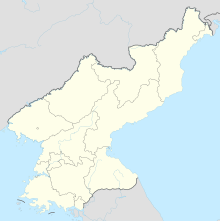Kalma Airport
Wonsan Kalma International Airport 원산갈마국제공항 Wonsan Galma Gukje Gonghang | |||||||||||||||||||
|---|---|---|---|---|---|---|---|---|---|---|---|---|---|---|---|---|---|---|---|
| Summary | |||||||||||||||||||
| Airport type | Civil/Military | ||||||||||||||||||
| Owner | North Korean government | ||||||||||||||||||
| Serves | Wonsan | ||||||||||||||||||
| Location | Wonsan, Kangwon-do, North Korea | ||||||||||||||||||
| Opened | September 24, 2015 (commercial flights) | ||||||||||||||||||
| Elevation AMSL | 7 ft / 2 m | ||||||||||||||||||
| Coordinates | 39°9′59″N 127°29′3″E / 39.16639°N 127.48417°E | ||||||||||||||||||
| Map | |||||||||||||||||||
| Runways | |||||||||||||||||||
| |||||||||||||||||||
Source: Google Earth | |||||||||||||||||||
Wonsan Kalma International Airport (IATA: WOS, ICAO: ZKWS) is a dual-use civil and military airport in Wonsan, Kangwon-do, North Korea. A new international terminal and passenger ramp opened in September 2015.[1]

History
Korean War
The ROKA Capital Division captured Wonsan Airfield on 10 October 1950.[2] The airfield was used by the United States Marine Corps and USAF under the designation K-25. By 12 October the USAF's Cargo Combat Command was flying supplies into the airfield.[2]
UN forces evacuated Wonsan in December 1950. The airfield was rendered unusable for the remainder of the war by the Blockade of Wonsan.
Modernisation
In July 2013, Supreme Leader Kim Jong-un approved plans for a complete redesign of the airport, turning it into an international airport for civilian use. The new airport was designed by the Chinese architectural firm PLT Planning & Architecture. The redesign will include two 36,000-square-foot oval-shaped terminals, one serving domestic flights and one serving international flights, that will each contain six gates and several duty-free stores. The runways will also be extended to 3500 metres. The airport is expected to serve 1.2 million visitors annually. It is expected to cost US$200 million.[3]
On 24 September, 2015, the first commercial civilian flight landed at Wonsan Airport as a part of an aviation-related tour with thirty passengers.[1] Photographs of the inaugural flight reveal a very much redesigned terminal building, doing away with the original dual-terminal circular layout. The new terminal has a single L-shaped building and two jetways.
It is reported that the airport cost around $200 million to build, with most of the work being carried out by the military. In July 2015, the first major event, an aeronautics display and contest, took place at the airport.[4]
Runways
Wonsan Airport has three runways. The shortest runway, 02/20, measures 501 m (1,643 ft). Runway 15R/33L measures 3,125 m (10,252 ft). Runway 15L/33R, which has not yet been completed, is to be the longest runway at a length of 3,504 m (11,497 ft).
References
- ^ a b Low, Nicole (28 September 2015). "Inside North Korea's newest airport: Secretive state unveils dazzling $200 million terminal on the site of a former military base in the hope of drawing in more overseas tourists". Daily Mail Australia. Retrieved 31 May 2016.
- ^ a b Futrell, Robert Frank (1983). The United States Air Force in Korea, 1950–1953. Washington, D.C.: Office of Air Force History, United States Air Force. p. 212. ISBN 9780912799711. OCLC 7555397.
- ^ Wong, Olga (29 July 2013). "Kim Jong-un gives nod to Hong Kong firm to redesign Pyongyang airport". South China Morning Post. Retrieved 29 July 2013.
- ^ Grisafi, John G (30 July 2015). "Wonsan Airport nears completion, with potential for impact on tourism and economy". NK News. Retrieved 17 May 2016.
{{country data {{{1}}} | air force/core | variant = | size = | name = }}

